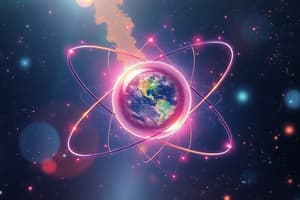Podcast
Questions and Answers
What is the Bohr Atom Model's description of the position of an electron?
What is the Bohr Atom Model's description of the position of an electron?
- A definite path
- A random movement
- A probability cloud (correct)
- An exact location
The atomic number Z of an element is equal to the total number of nucleons in the nucleus.
The atomic number Z of an element is equal to the total number of nucleons in the nucleus.
False (B)
What is the definition of isotopes?
What is the definition of isotopes?
Atoms that have the same number of protons (Z1= Z2), but a different number of neutrons (N).
The mass number A of an element is equal to the total number of _________________ in the nucleus.
The mass number A of an element is equal to the total number of _________________ in the nucleus.
What is the unit of energy obtained from Einstein's Equivalency Formula?
What is the unit of energy obtained from Einstein's Equivalency Formula?
The mass of an electron is negligible compared to the mass of a proton.
The mass of an electron is negligible compared to the mass of a proton.
Match the following elements with their properties:
Match the following elements with their properties:
What is the relationship between the mass of a particle and its energy, according to Einstein's Equivalency Formula?
What is the relationship between the mass of a particle and its energy, according to Einstein's Equivalency Formula?
The energy of 1 u is equal to __________________ J.
The energy of 1 u is equal to __________________ J.
Flashcards are hidden until you start studying
Study Notes
Introduction to Physics
- The Bohr Atom Model describes the atom, stating that the exact position of an electron cannot be known at any given time.
- The position of an electron is described as a probability, referred to as an electron cloud.
Atomic Structure
- The atomic number (Z) of an element is equal to the number of protons in the nucleus of that element.
- The mass number (A) of an element is equal to the total number of nucleons (protons + neutrons).
Isotopes of Elements
- Isotopes are atoms that have the same number of protons (Z1= Z2), but a different number of neutrons (N1 ≠ N2), resulting in different atomic masses and physical properties.
Calculating Atomic Mass
- Example: The average atomic mass of Boron is 11.009305 u. To find the mass of the nucleus of one boron atom in kg, subtract the mass of 5 electrons from the atomic mass.
Einstein's Equivalency Formula
- The formula relates the mass of a particle to its energy.
- The energy of 1 u is calculated as: E = (1u) x c2 = 1.49 x 10-10 J = 931.5 MeV (megaelectron volt).
Studying That Suits You
Use AI to generate personalized quizzes and flashcards to suit your learning preferences.



